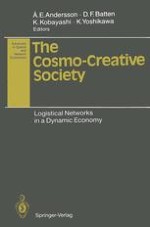1993 | OriginalPaper | Chapter
Some Consequences of ‘Recurrence and Expansion’: What Can We Learn about Logistic Networks from Chaos?
Author : Donald G. Saari
Published in: The Cosmo-Creative Society
Publisher: Springer Berlin Heidelberg
Included in: Professional Book Archive
Activate our intelligent search to find suitable subject content or patents.
Select sections of text to find matching patents with Artificial Intelligence. powered by
Select sections of text to find additional relevant content using AI-assisted search. powered by
Understanding a logistic network involves developing an appreciation for the complexities associated with the component parts of a network. This includes an understanding of the movement of money, of commodities, of people, and of the production and consumption of goods and services. (See, for instance, Andersson and Johansson, 1984). The essence of many of these component parts can be captured by seemingly simple models. However, even simple models admit consequences that are surprisingly complex! Paradoxes abound, dynamical motion that intuitively should be ‘simple’ can be highly erratic, and small changes in assumptions can cause radically different conclusions. At first glance, this complexity is surprising if only because much of economics and decision theory is based upon concepts of aggregation and optimization — concepts that one might expect to introduce stability, reliability, and predictability to the conclusions of the resulting model. Yet, this need not be the case. Why?
